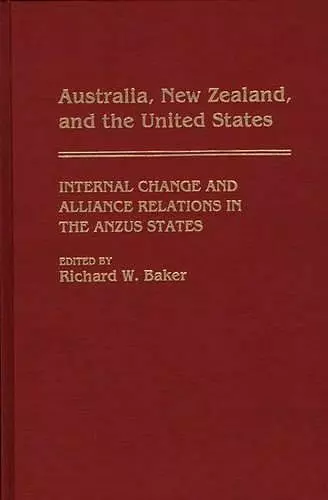Australia, New Zealand, and the United States
Internal Change and Alliance Relations in the ANZUS States
Format:Hardback
Publisher:Bloomsbury Publishing PLC
Published:19th Apr '91
Currently unavailable, and unfortunately no date known when it will be back

An international team of experts examines the evolution of the relationships among participants in ANZUS, the alliance for common security formed by Australia, New Zealand, and the U.S. in 1951. Elements of distinctiveness and similarity are brought into balance and implications for the future of the relationship are proposed.
The evolution of the relationships among the ANZUS nations--the acronym for the Australia, New Zealand, and U.S. alliance for common security formed in 1951--is examined in this volume's essays. They also look at the implications of changing relationships for the entire Asia-Pacific region. Editor Richard W. Baker, director of the East-West Center's Australia-New Zealand-U.S. relations project, has commissioned experts from academia, government, and other backgrounds from the three countries to research the full range of sociopolitical change in the three nations and the changing perceptions of their national roles and relationships. This study comes at a particularly relevant juncture in world affairs because the defusing of the Cold War has prompted nations worldwide to rethink their national and international security measures and allied priorities. Throughout the volume's main divisions: Social Dynamics, Political Evolution, Images and Attitudes, and Implications for Relationships, the interdisciplinary team of writers takes a hard look at the long-held assumption, based on common language and cultural roots, of fundamental shared values among the three nations. Each society has evolved in individual and dramatic ways based on changes in demographics, political agendas, and outlooks on their international roles, security situations, and appropriate national policies. Individual chapters zero in on key elements in the national experiences of each country that have influenced the nature and conduct of the relationships among the three partners. Finally, the volume draws a balance between elements of distinctiveness and similarity and projects implications for the future of the relationships. For academics and students of international relations, the book provides a case study of the long-term evolution of alliance relationships and provides instructive comparisons and contrasts with the post-Cold War circumstances of other American alliances. For professionals and others whose interests involve working in or between two or more of these countries, this volume is an invaluable handbook that contains an excellent summary of their recent histories, major social and political developments, and problems, as well as their characteristic world views and the major factors which affect the dynamics of their interrelationships.
ISBN: 9780275937973
Dimensions: unknown
Weight: 624g
304 pages